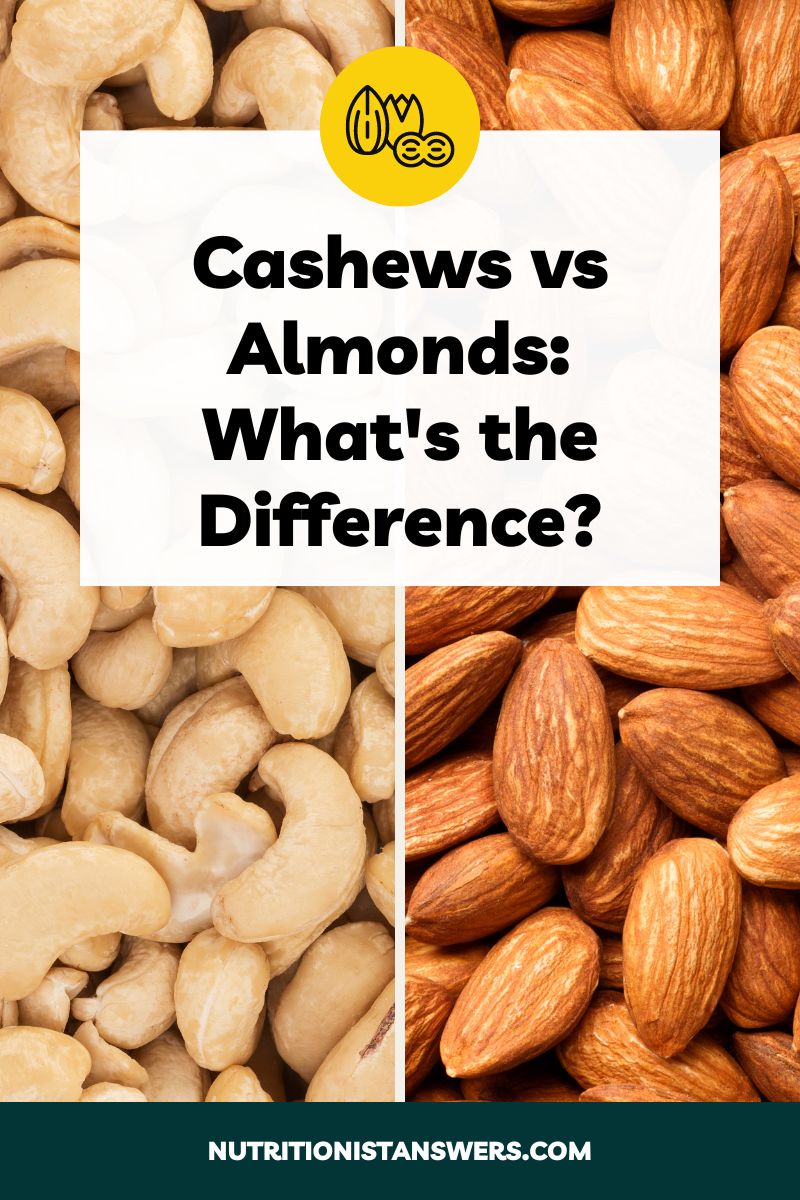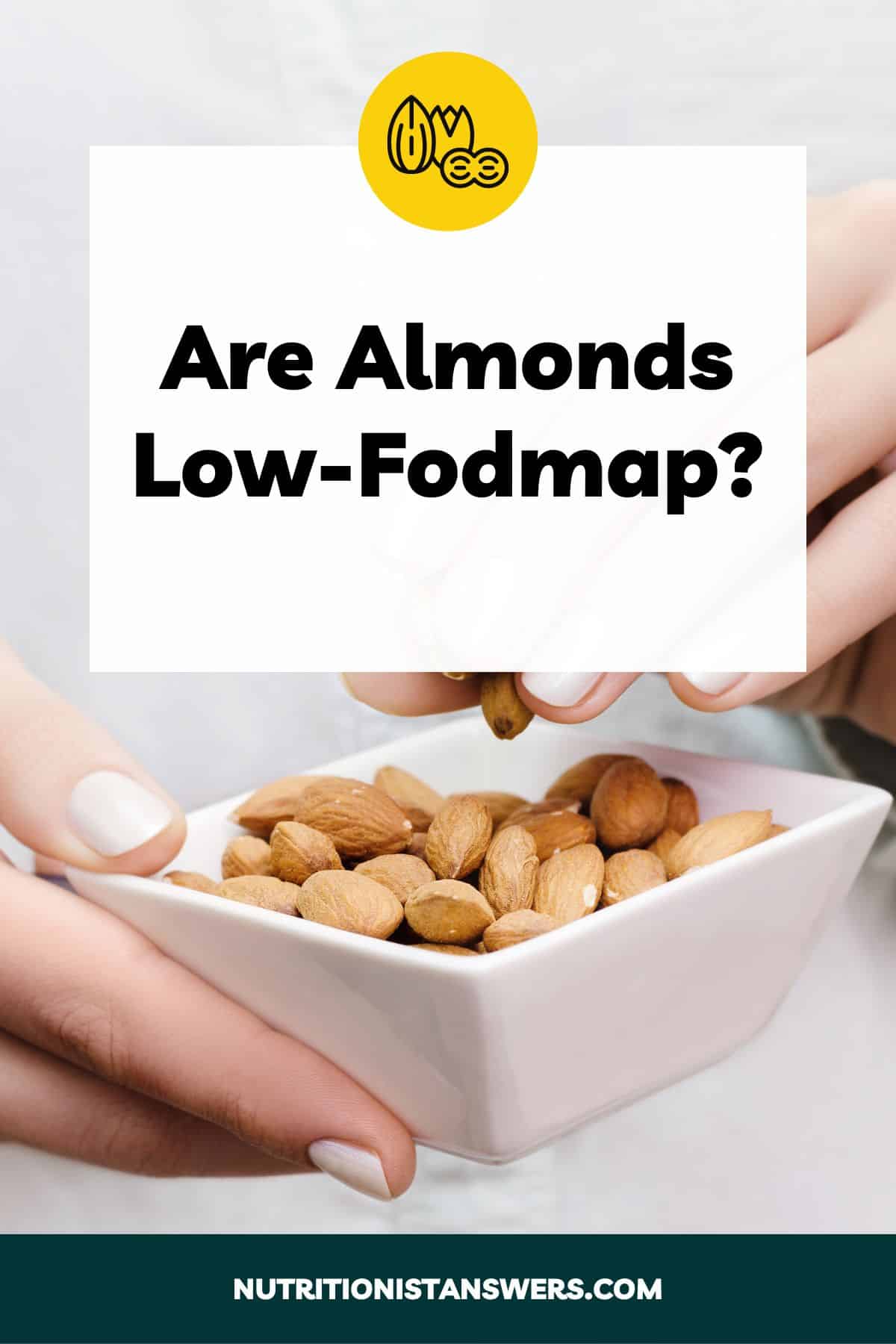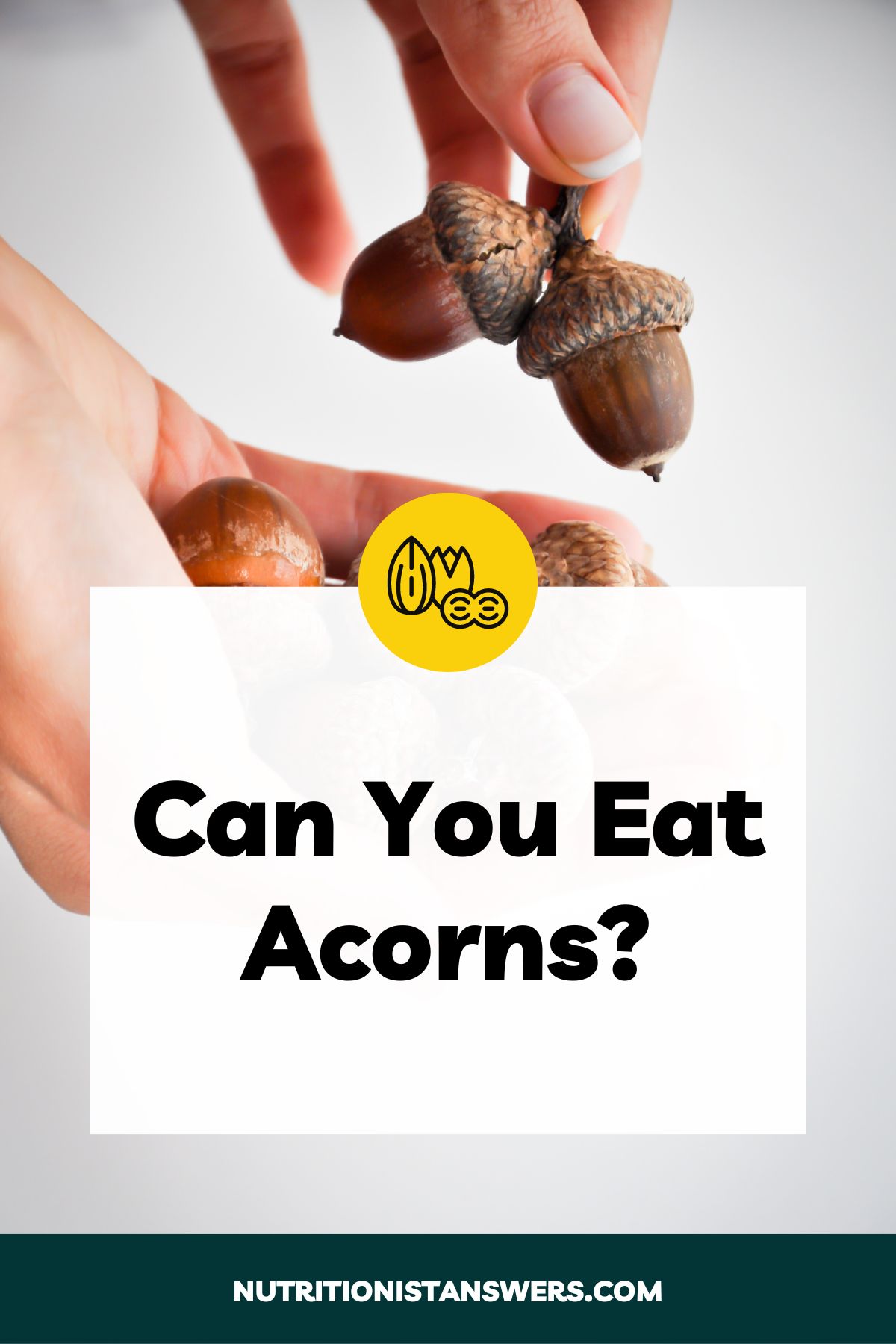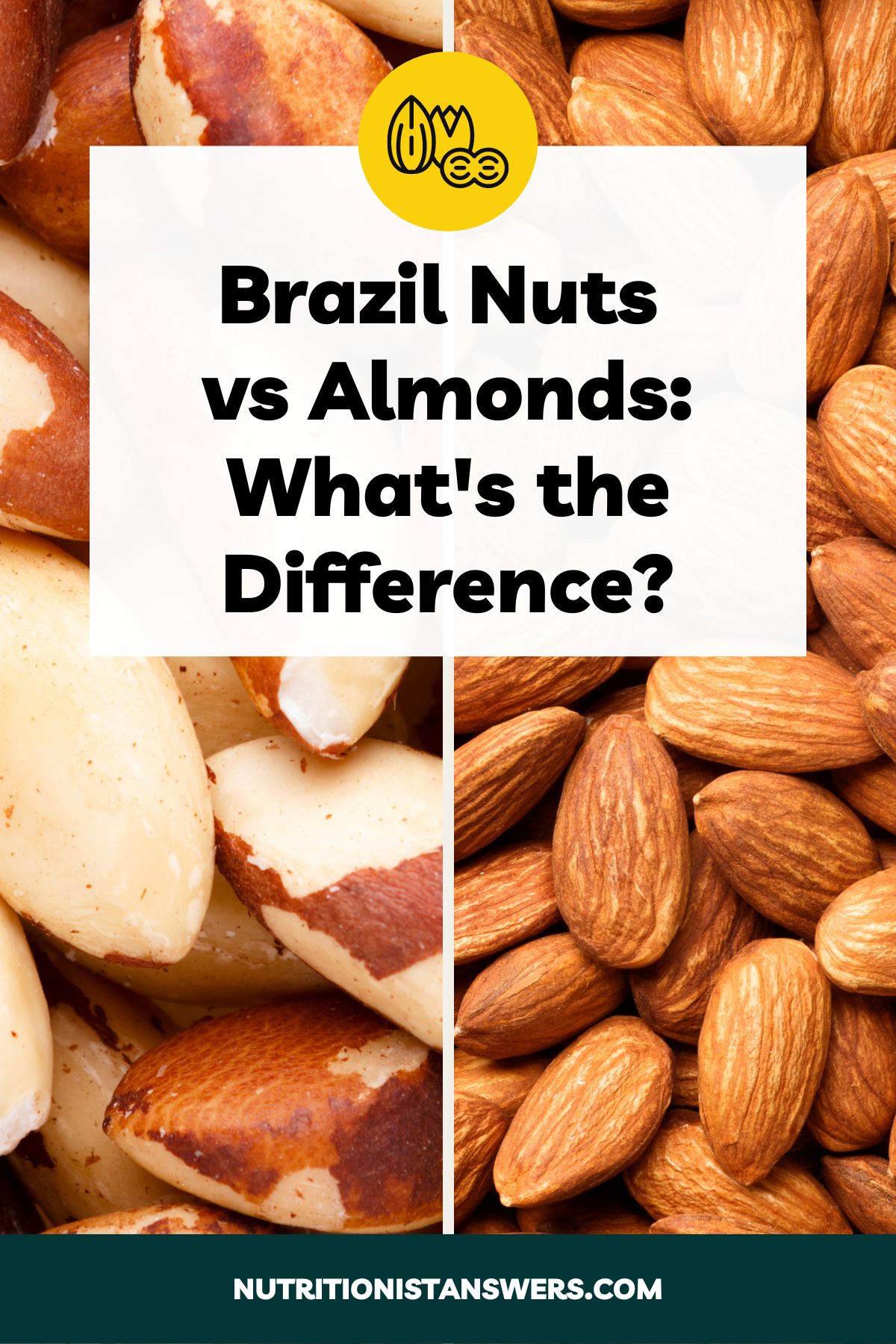Cashews and almonds are two popular nut varieties that many people enjoy as snacks and use in a variety of recipes, from salads and side dishes to baked goods and desserts.
Both nuts are excellent sources of healthy fats, vitamins, and minerals and offer a wide range of health benefits. However, there are some important differences in flavor, texture, and cost.
In this article, we’ll explore the similarities and differences between cashews and almonds, in terms of nutrition, taste, available forms, prices, and uses.
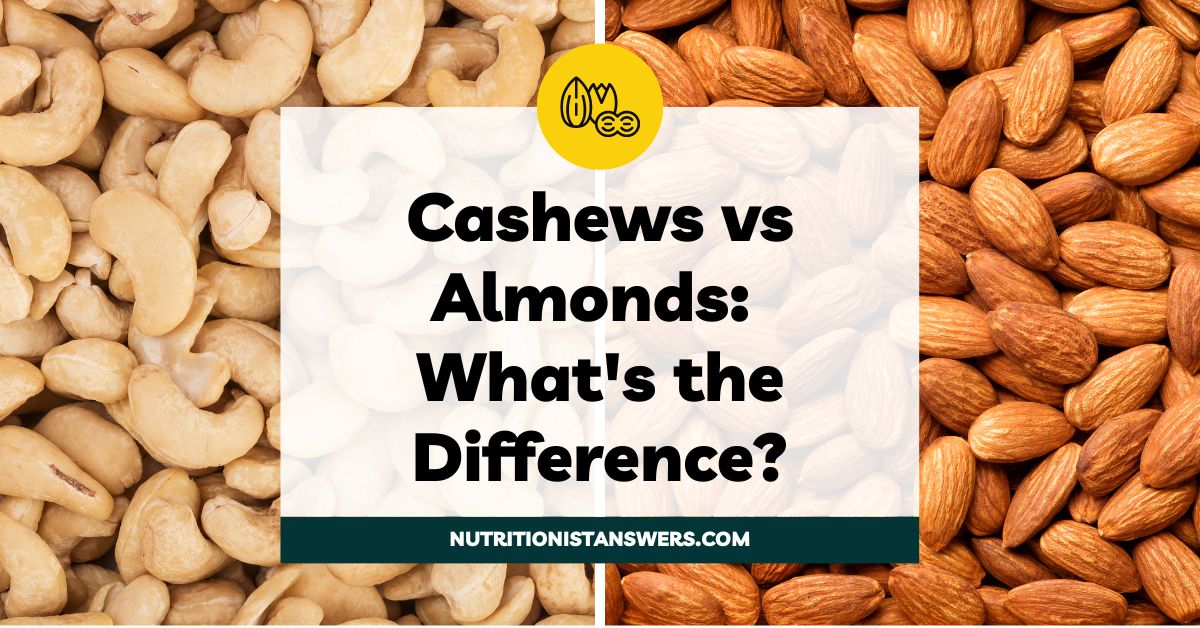
Please note that this article contains affiliate links. If you click one of these links and make a purchase, we may earn a commission. As an Amazon Associate, we earn from qualifying purchases.
What are cashews?
Cashews are nuts that grow on cashew trees (Anacardium occidentale), native to Brazil and later introduced by European explorers to Asia and Africa (1).
They are encased in a hard, grayish-brown shell that is shaped like a kidney. Inside, the edible nut has the same shape and is cream-colored or golden brown with a smooth surface.
Cashews boast a delicate, mildly sweet and buttery flavor with a hint of earthiness. They provide a satisfying crunch when bitten into but become creamier as you chew, similar to peanuts.
Most grocery stores carry cashews, either whole or in halves and pieces, with their shells removed. You can find them in the baking or snack sections, as well as the bulk foods aisle.
Cashews are a versatile nut, often enjoyed as a snack on their own or used as a garnish in both sweet and savory dishes. They can also be processed into cashew butter, ground into flour for gluten-free baking, or blended into cashew milk as a dairy alternative.
What are almonds?
Almonds, a type of tree nut, are produced by the almond tree (Prunus dulcis), which is native to Central Asia and is now grown worldwide (2).
Enclosed in a hard, teardrop-shaped shell, the edible part of the almond is a creamy-white kernel, wrapped in a thin brown skin.
Almonds are notable for their crunchy texture and a nuanced, nutty flavor that’s mildly sweet with a faint bitter undertone.
You can find almonds in the baking aisle, snack aisle, or bulk foods section of most supermarkets, health food stores, and online grocery retailers.
Almonds are an incredibly adaptable ingredient — perfect for snacking, enhancing salads, garnishing baked treats, or processing into almond milk or butter.
Cashews vs almonds
Cashews are buttery, rich, and slightly sweet with a soft and creamy texture, while almonds are hard and crunchy and have a more subtle, nutty flavor.
Almonds are higher in calories, protein, fat, and fiber. Cashews, on the other hand, are fairly high in carbohydrates compared to almonds and many other nuts.
Both nuts provide a good amount of B vitamins and minerals. Cashews are packed with copper, magnesium, and zinc, while almonds provide close to 50% of the Daily Value (DV) for vitamin E.
Here’s a more detailed review of how they compare in flavor, nutrition, available forms, prices, and recommended uses:
Flavor comparison
Cashews offer a rich, buttery and slightly sweet flavor, while almonds present a more neutral, subtly sweet and nutty taste.
Texture-wise, almonds provide a hard, satisfying crunch, whereas cashews have a soft, almost creamy texture.
Cashews pair well with sweet flavors like honey and coconut as well as more savory combinations such as chili lime and stir-fried chicken.
The more neutral, subtle taste of almonds complements a diverse range of flavors, from fruit and chocolate to roasted vegetables and fish.
Nutrition comparison
Here’s a side-by-side comparison of the calorie and macronutrient content of cashews and almonds, based on a 1-ounce (28-gram) serving size (3, 4):
| Nutrient | Cashews, unroasted (28g) | Almonds, unroasted (28g) |
| Calories | 157 | 164 |
| Protein | 5 grams | 6 grams |
| Fat | 12 grams | 14 grams |
| Saturated fat | 2 grams | 1 gram |
| Monounsaturated fat | 7 grams | 9 grams |
| Polyunsaturated fat | 2 grams | 4 grams |
| Carbohydrates | 9 grams | 6 grams |
| Fiber | 1 gram | 3.5 grams |
Calories
Cashews are slightly lower in calories than almonds.
A 1-ounce (28-gram) serving of cashews provides 157 calories, while the same serving of almonds offers 164 calories.
Protein
Almonds provide 20% more protein per serving than cashews (6 grams vs 5 grams, respectively).
If you’re trying to include more protein in your diet, almonds are the slightly better nut choice.
Fat
Both cashews and almonds are high in fat, but almonds provide 17% more fat per serving than cashews.
A 1-ounce (28-gram) serving of almonds contains 14 grams of fat, while an equal serving of cashews includes 12 grams of fat.
Cashews are high in saturated fat, while almonds provide more heart-healthy monounsaturated and polyunsaturated fats.
Carbohydrates
Cashews are higher in carbohydrates than almonds and many other nuts. A 1-ounce serving of cashews provides 9 grams of carbohydrates and 1 grams of fiber.
Almonds are 33% lower in carbohydrates than cashews, with 6 grams per serving. If you’re looking for a lower carb snack option, almonds are the better nut choice.
Vitamins and minerals
Here’s an overview of the vitamin and mineral content of cashews and almonds, based on a 1-ounce (28-gram) serving (3, 4):
| Nutrient | Cashews, unroasted (28g) | Almonds, unroasted (28g) |
| Vitamin A | 0 mcg RAE (0% DV) | 0 mcg RAE (0% DV) |
| Vitamin B1 (Thiamin) | 0.1 mg (8% DV) | 0.06 mg (5% DV) |
| Vitamin B2 (Riboflavin) | 0.02 mg (2% DV) | 0.3 mg (23% DV) |
| Vitamin B3 (Niacin) | 0.3 mg (2% DV) | 1 mg (6% DV) |
| Vitamin B5 (Pantothenic acid) | 0.2 mg (4% DV) | 0.1 mg (2% DV) |
| Vitamin B6 (Pyridoxine) | 0.1 mg (6% DV) | 0.04 mg (2% DV) |
| Vitamin B9 (Folate) | 7 mcg (2% DV) | 13 mcg (3% DV) |
| Vitamin B12 (Cobalamin) | 0 mcg (0% DV) | 0 mcg (0% DV) |
| Vitamin C | 0.1 mg (<1% DV) | 0 mg (0% DV) |
| Vitamin D | 0 mcg (0% DV) | 0 mcg (0% DV) |
| Vitamin E | 0.3 mg (2% DV) | 7 mg (47% DV) |
| Vitamin K | 10 mcg (8% DV) | 0 mcg (0% DV) |
| Choline | Not listed | 15 mg (3% DV) |
| Sodium | 3 mg (<1% DV) | 0.3 mg (<1% DV) |
| Potassium | 187 mg (4% DV) | 208 mg (4% DV) |
| Calcium | 11 mg (1% DV) | 76 mg (6% DV) |
| Phosphorus | 168 mg (13% DV) | 136 mg (11% DV) |
| Magnesium | 83 mg (20% DV) | 77 mg (18% DV) |
| Iron | 1.9 mg (11% DV) | 1.1 mg (6% DV) |
| Zinc | 1.6 mg (15% DV) | 0.9 mg (8% DV) |
| Copper | 0.62 mg (69% DV) | 0.29 mg (32% DV) |
| Manganese | 0.5 mg (22% DV) | 0.6 mg (26% DV) |
| Selenium | 6 mcg (11% DV) | 1 mcg (2% DV) |
Almonds are higher in riboflavin, calcium, and manganese than cashews. They also offer close to 50% of the Daily Value (DV) for vitamin E.
Cashews, on the other hand, are packed with minerals — they provide more phosphorus, magnesium, iron, zinc, copper, and selenium than almonds.
Special Diets
If you’re following a special diet, you may be wondering whether cashews or almonds are a better choice for you.
Dairy-free diet
Both cashews and almonds are naturally dairy-free.
Gluten-free diet
Both almonds and cashews are naturally gluten-free and can be consumed on a gluten-free diet.
Ketogenic diet
For people following a keto diet, almonds are a better choice than cashews.
Almonds have 6 grams of carbs and 3.5 grams of fiber per 1-ounce (28-gram) serving, while an equal portion of cashews contains 9 grams of carbs and 1 gram of fiber.
Cashews can still be enjoyed on a keto diet, but keep in mind that a single serving (1 ounce) can easily take up 20-45% of your total daily carb allowance.
Low-fat diet
Cashews and almonds are very high in fat and may need to be limited on a low-fat diet.
Generally, low-fat diets limit fat to 30% or less of total daily calorie intake (5). On a 2,000-calorie low-fat diet, a single serving of almonds would take up about one-fifth of your daily fat allowance.
Cashews are a slightly better choice but would still take up about one-sixth of your daily fat allowance on a 2,000-calorie low-fat diet.
Low-FODMAP diet
Both cashews and almonds are considered high-FODMAP, according to the Monash University FODMAP Diet app.
A 1-ounce serving (about 20 nuts) of almonds is high in galactans. Almond butter and almond flour are also high in galactans in servings larger than 1 tablespoon and ⅓ cup, respectively.
Almonds can only be consumed on the low-FODMAP diet in portions of 10 almonds or less (roughly half the typical serving size for almonds).
Cashews are high in both fructans and galactans, even in very small portions (10 cashews or less).
Low sodium diet
Almonds and cashews are both naturally low in sodium. However, many nuts are salted and usually contain around 80 mg (or more) of sodium per serving.
If you’re following a low-sodium diet, which limits sodium to less than 2300 mg, you may want to choose unsalted or lightly salted nuts instead (6).
Vegetarian diet
Both cashews and almonds are plant-based and can be eaten on a vegetarian diet.
Vegan diet
Almonds and cashews are both vegan, since they come from plants.
Available forms
1. Whole (cashews and almonds)
Almonds and cashews are usually sold whole with their shells removed.
You can find them at most supermarkets and health food stores, in the baking aisle, bulk foods section, or snack aisle. They can also be purchased in bulk online from Nuts.com.
Buying whole nuts and chopping them at home is usually less expensive than buying pre-chopped or sliced nuts.
2. Pre-cut (almonds only)
Pre-cut almonds are a hassle-free option that can be used in recipes like salads and baked goods without any preparation.
Almonds are available sliced or slivered (peeled and cut into tiny sticks) and can be found in the baking aisle or bulk foods section of the grocery store.
Cashews aren’t often available pre-cut, but they are sometimes sold as “halves and pieces” in the snack aisle of supermarkets.
3. Flour (cashews and almonds)
Nut flours made from almonds or cashews can be used to replace wheat flour in baked goods, breaded meats, and more.
Almond flour is usually located in the baking aisle or bulk foods section of most supermarkets, and can also be purchased online.
Cashew flour is less common than almond flour but can be purchased at many health food stores as well as online. Nature’s Eats is a brand available on Amazon.
4. Butters (cashews and almonds)
Cashew butter and almond butter are two popular nut butters, both made from grinding their respective nuts into a paste.
Almond butter is known for its subtle, nutty taste, while cashew butter offers a richer, creamier flavor. Both can be found at most grocery stores, health food stores, and online marketplaces.
To save money, you can buy nuts in bulk and make your own nut butter using a food processor or high-powered blender.
5. Oil (almonds only)
Almond oil (also called sweet almond oil) is a cooking oil made by pressing almonds. It is different from bitter almond oil, an essential oil extracted from bitter almonds (6).
Sweet almond oil has a mild, nutty flavor and a high smoke point of 221°C (430°F) (7). It’s great for baking, roasting, and frying, as well as adding flavor to salads and other side dishes.
While cashew oil can be used for cooking, it’s more often sold for cosmetic purposes.
6. Milks (almonds and cashews)
Both cashew milk and almond milk are two popular non-dairy milk products that can be found in both the refrigerated and shelf-stable sections of most grocery stores.
Almond milk has been mass-produced for a longer period of time, so you may find more varieties at a lower price point than cashew milk.
Cost
Cashews are about twice as expensive as almonds.
A 1-pound (16-ounce) package of cashews typically costs $9-12, while almonds cost $5-7 for the same amount.
To get the most bang for your buck, you can buy nuts in bulk and store them in the freezer — keeping them cool will help keep them from going rancid.
Recommended uses
Cashews and almonds can be used in many of the same ways.
1. Trail mixes and snacks
Both almonds and cashews are excellent ingredients for trail mixes and snack bars, as they add a satisfying crunch and a delicious nutty flavor.
Cashews, with their rich and slightly sweet flavor, would be perfect for a tropical-themed trail mix or snack bar with dried pineapple, coconut flakes, and macadamia nuts.
Almonds, on the other hand, pair well with walnuts, pepitas (pumpkin seeds), dark chocolate chunks, and dried cranberries.
2. Baked goods and desserts
Cashews and almonds can be a great way to elevate your favorite baked goods and desserts, such as cakes, pies, cookies, and ice cream.
Cashews are ideal for adding to rich desserts like brown butter blondies, toffee cookies, salted caramel cheesecake, and dark chocolate brownies.
Almonds are incredibly versatile and harmonize easily with most other ingredients. Enjoy them in almond cookies and tortes or as a crunchy topping for brownies and fruit cobblers.
You might want to use almonds over cashews when you’re aiming for a lighter flavor profile, while cashews are a better choice if you want a richer flavor profile.
3. Salads and side dishes
Almonds and cashews are great for adding a satisfying crunch and some healthy fats to salads and side dishes.
Cashews, with their buttery and slightly sweet taste, pair well in Asian-inspired dishes like green mango salad with cashews or Thai cashew chicken.
Almonds, on the other hand, offer a milder flavor and a firmer crunch, making them a great addition to green leafy salads, particularly when paired with tangy goat cheese, sweet dried cranberries, and a light vinaigrette.
You might prefer almonds in salads where a lighter, more neutral nut flavor is desired, while cashews could be your go-to for heartier, flavor-packed side dishes.
4. Breaded meats and fish
Try adding cashews or almonds to the breading for meats and fish for a crunchier texture and richer, nuttier flavor.
Both nuts make an excellent crust for milder, more delicate proteins like chicken, tilapia, and halibut. Almonds pair well with seasonings like lemon zest and parsley, while cashews can be mixed with shredded coconut for a more tropical flavor.
Begin by grinding the nuts in a food processor until they reach a fine consistency. Then, combine them with breadcrumbs or flour and your chosen seasonings in a separate bowl. After dipping your meat or fish in a beaten egg, fully coat them in the breading mixture.
Fry the breaded protein until thoroughly cooked, keeping in mind that nuts have a tendency to burn quickly. Strive for a crust that is golden brown and crispy on the outside.
Final thoughts
Cashews are buttery, rich, and a little sweet with a soft and creamy texture, while almonds are harder, crunchier, and have a more delicate nutty flavor.
Almonds provide more calories, fat, protein, and fiber, and offer close to 50% of the DV for vitamin E. Cashews are higher in carbohydrates and packed with copper, magnesium, and zinc.
Cashews and almonds are available in many different forms, including whole, flour, nut butter, oil, and nut milk. Cashews are about twice as expensive compared to almonds.
Both nuts can be used in many of the same ways, such as trail mixes, baked goods and desserts, salads, and breaded meats.
Want to know how almonds compare to other nuts? Check out our in-depth comparisons of almonds vs pistachios, almonds vs peanuts, almonds vs brazil nuts, almonds vs walnuts, and almonds vs pecans.
Amy Richter is a Registered Dietitian Nutritionist based in Missouri. She is an experienced nutrition writer and medical advisor for Healthline and Medical News Today. Amy is passionate about all things food-related and enjoys translating complex science into easy-to-understand articles.

